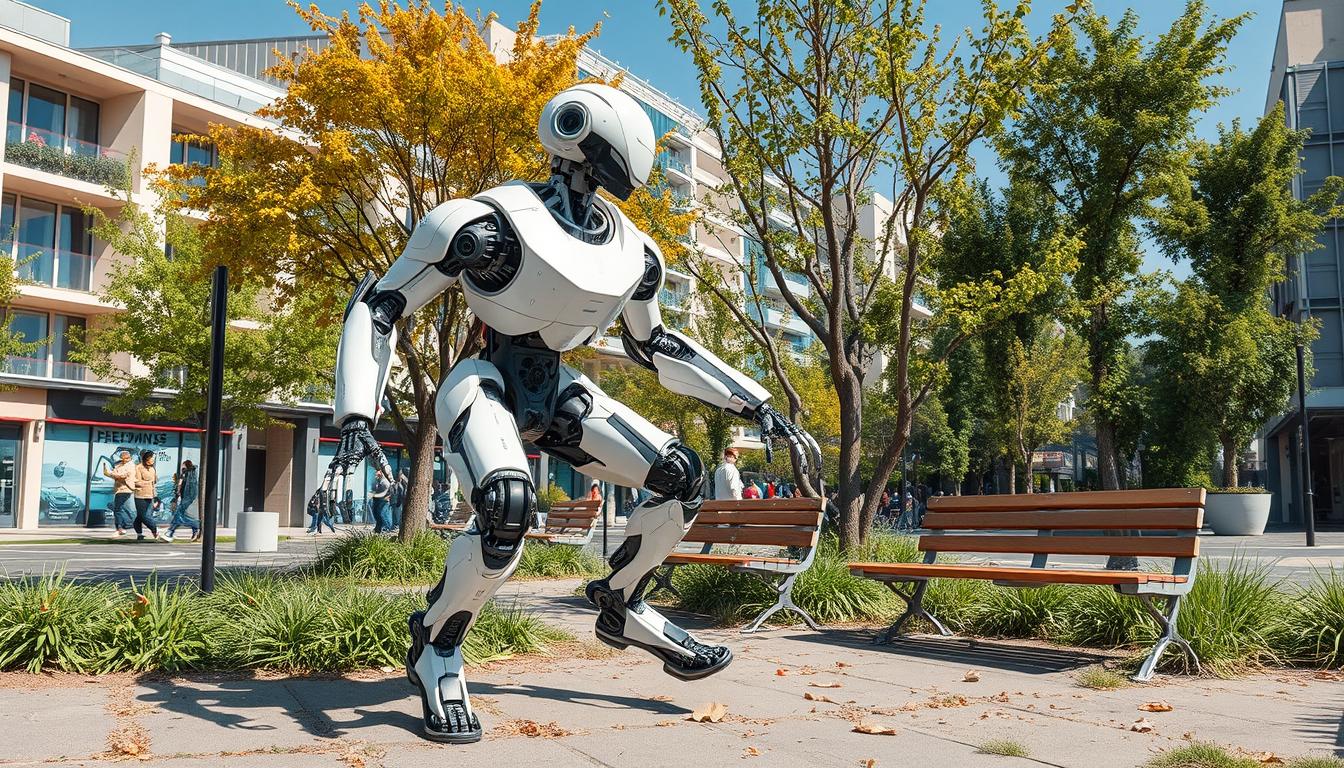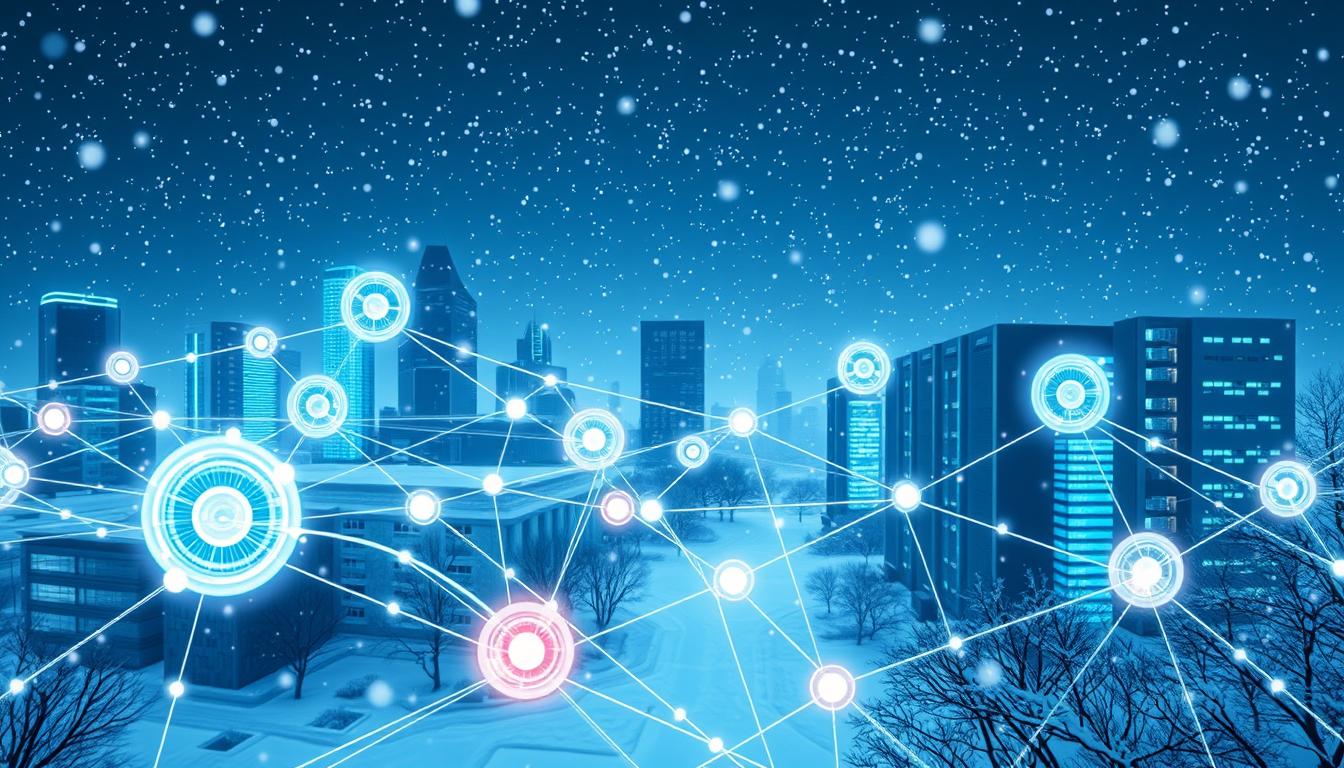Artificial intelligence is changing how we interact with the world. AI systems are getting smarter to work better with us. This change is big for many fields like robotics, healthcare, and education.
AI can now do things that humans used to do. It can learn and get better at tasks. This helps us work together in new ways.
According to the Accenture Technology Vision 2025 report, AI is becoming more than just a tool. It’s becoming a partner and a helper. It’s working with us in new ways, making things better.
AI is making a big difference in many areas. It can learn and do things on its own. This is helping us work together in new ways.
AI is changing how we live and work. It’s making things better and helping us do more together. This is all thanks to AI’s ability to work with the physical world.
Key Takeaways
- Artificial intelligence is gaining physical intelligence to better interact with the real world through real world interaction.
- AI systems are able to learn and adapt, performing complex tasks that were previously exclusive to humans, and are a key aspect of ai development.
- The integration of AI with physical systems is expected to revolutionize the way we live and work, enabling new forms of collaboration and innovation, and is a key aspect of physical intelligence.
- AI will increasingly act as a technology development partner, a personal brand ambassador, power robotic bodies in the physical world, and foster a new symbiotic relationship with people, and is a key aspect of artificial intelligence.
- The advancement of AI has significant implications for various industries, including robotics, healthcare, and education, and is a key aspect of real world interaction.
- Physical intelligence is a key aspect of AI development, enabling AI systems to better interact with the real world, and is a key aspect of artificial intelligence.
Understanding Physical Intelligence in AI Systems
AI is getting better at working with the real world. It’s gaining physical intelligence. This means machines can see, think, and move around like us.
Machine learning is key to AI’s growth. It helps AI learn from what it sees and feels. This way, AI can move and act in the world better.
Defining Physical Intelligence
Physical intelligence lets AI see and react to its surroundings. It can move around and touch things. AI can even talk to other machines.
Key Components of Real-World Interaction
The main parts of real-world interaction are:
- Perception: Seeing and understanding what’s around it.
- Reasoning: Making smart choices based on what it sees.
- Action: Moving and doing things in the world.
The Evolution from Digital to Physical AI
AI is changing from just being digital to being physical. This change comes from better machine learning and robotics. Now, AI can learn and act in the world in new ways.
| Component | Description |
|---|---|
| Perception | The ability to perceive and understand sensory inputs from the physical environment. |
| Reasoning | The ability to reason and make decisions based on perceived sensory inputs. |
| Action | The ability to act and interact with the physical environment. |
To Interact with the Real World, AI Will Gain Physical Intelligence
AI systems are getting smarter. They will soon learn and adapt in complex places. This means they can work with the real world better and faster.
Karthik Narain, from Accenture, says new AI models and systems are key. They help companies create their own smart digital brains.
The growth of physical intelligence in AI is very important. It lets machines work with the real world. This is thanks to technology advancement and new AI designs.
As ai development keeps getting better, machines will work with the real world more easily.
Some big benefits of future technology in AI are:
- They work better in complex places
- They learn and adapt more
- They can work with the physical world more

With physical intelligence and ai development, machines will get smarter. They will work better with humans. This will make many industries better.
As technology advancement keeps going, we’ll see even smarter AI. They will work with the real world in a smarter way.
| Technology | Benefits |
|---|---|
| AI Development | Improved efficiency and effectiveness |
| Physical Intelligence | Enhanced ability to interact with the physical world |
| Future Technology | Increased ability to learn and adapt |
Breakthrough Technologies Enabling Physical AI
Several new technologies are helping make physical AI possible. These include advanced sensors, neural networks, robotic learning, and haptic feedback. Innovation in AI is key, with NVIDIA leading the way.
Some important technologies are:
- Advanced sensor integration, which lets machines see and react to their surroundings
- Neural network architectures, which help machines learn and grow
- Robotic learning systems, which let machines learn from doing things
- Haptic feedback mechanisms, which make machines feel like they’re touching things
These tools are used in many robotics applications. They help with things like self-driving cars and making factories run better. Machine learning and technology advancement are making these AI systems smarter.
| Technology | Description |
|---|---|
| Advanced Sensor Integration | Enables machines to perceive and respond to sensory inputs |
| Neural Network Architectures | Enables machines to learn and adapt in complex environments |
| Robotic Learning Systems | Enables machines to learn from experience and adapt to new situations |
| Haptic Feedback Mechanisms | Enables machines to interact with the physical world in a more intuitive and natural way |
Current Applications and Real-World Implementation
Artificial intelligence is changing how we interact with the world. It’s used in many areas like robotics, healthcare, education, and transportation. This technology makes things more efficient and helps us come up with new ideas.
Most executives think AI makes us rethink how we use technology. They see it as a big chance to make things better.
Physical AI lets machines work better with the world. This leads to new ways of working together and finding new ideas. Real-world interaction is key here. It makes things work much better.
Some examples of physical AI in action include:
- Healthcare: AI robots help in surgeries and care for patients.
- Manufacturing: AI makes production faster and cheaper.
- Automotive: AI cars are safer and cut down on accidents.
The field of physical AI is growing fast. It will change many industries a lot. As AI gets better, we’ll see even more cool uses in the real world.
The demand for physical intelligence and real-world interaction is growing. This means the market for AI services will grow a lot too.
| Industry | Application | Benefits |
|---|---|---|
| Healthcare | AI-powered robots | Improved patient care and reduced costs |
| Manufacturing | Physical AI | Improved production efficiency and reduced costs |
| Automotive | AI-powered vehicles | Improved safety and reduced accidents |
Conclusion: The Future Landscape of Physical AI Integration
The future of physical AI is full of excitement and new ideas. Machines will get smarter and better at working with the world. They will learn and solve problems in new ways.
Physical AI will make machines work better in complex places. This means they can do things more efficiently and effectively.
Experts say artificial intelligence (AI) will be huge by 2025. It will move from behind-the-scenes work to being right in front of us. This change will happen thanks to edge computing.
This will change how we see healthcare and logistics. It will make our world more connected and efficient.
As future technology grows, we must trust AI. We need to fix issues like bias and make sure AI is open and fair. This will help AI grow and change our world for the better.
The mix of IoT, AI, and spatial computing will change how we see things. It will make our world more connected and interactive. This will shape how we interact with the real world.


